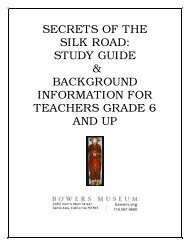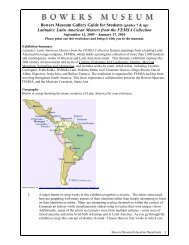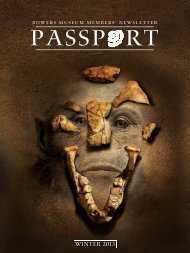A Resource Guide for Students and Teachers - Bowers Museum
A Resource Guide for Students and Teachers - Bowers Museum
A Resource Guide for Students and Teachers - Bowers Museum
You also want an ePaper? Increase the reach of your titles
YUMPU automatically turns print PDFs into web optimized ePapers that Google loves.
28 TERRA COTTA WARRIORS<br />
Bell used to sound<br />
retreat <strong>for</strong> troops<br />
wall; this is why it is called the longest<br />
cemetery in the world.<br />
During the First Emperor’s time,<br />
the walls were rein<strong>for</strong>ced with earth,<br />
wood, <strong>and</strong> stone. Later during the<br />
Ming Dynasty (1368-1644 CE), the<br />
use of bricks, tile, <strong>and</strong><br />
limestone made the<br />
building of the wall<br />
move at a faster pace.<br />
Although the<br />
Great Wall has been<br />
a UNESCO World<br />
Heritage Site since<br />
1987, much of it<br />
is in disrepair.<br />
In some areas,<br />
nearby villagers<br />
have taken<br />
parts of the<br />
brick wall to<br />
build their<br />
homes,<br />
while in<br />
other<br />
areas the<br />
wall is<br />
crumbling <strong>and</strong> is not safe <strong>for</strong> touring.<br />
In Beijing the most well-preserved<br />
parts of the wall are visited by about<br />
four million visitors each year. The<br />
Great Wall today is more than 4,000<br />
miles long.<br />
Activities:<br />
Individually, or in groups,<br />
research different areas of the Great<br />
Wall listed below:<br />
• Great Wall in Liaoning<br />
• Great Wall in Hebei<br />
• Great Wall in Beijing<br />
• Great Wall in Tianjin<br />
• Great Wall in Shanxi<br />
• Great Wall in Inner Mongolia<br />
• Great Wall in Ningxia<br />
• Great Wall in Shaanxi<br />
• Great Wall in Gansu<br />
Create a visual aide <strong>and</strong> give<br />
a presentation summarizing<br />
your section of the wall. Include<br />
in<strong>for</strong>mation such as:<br />
• Where your portion is located<br />
• When it was built<br />
• What materials were used<br />
• A brief history of the dynasty<br />
responsible <strong>for</strong> that section<br />
Conduct research on the Great<br />
Wall <strong>and</strong> write a persuasive essay<br />
arguing whether the Great Wall<br />
should be preserved or whether it is<br />
not worth saving. Use the website<br />
listed in the <strong>Resource</strong> <strong>Guide</strong>.<br />
16. Math/Geography Activity<br />
If the Great Wall were moved from<br />
China to North America, how far<br />
would it reach? On a map of North<br />
America, show the distance of 4,000<br />
miles. It does not have to go in a<br />
straight line. The wall could go<br />
from ________(name a city) to<br />
__________(name a city). You<br />
may list many cities along the route.<br />
Research the border between the<br />
U.S. <strong>and</strong> Mexico. Compare its use,<br />
composition, <strong>and</strong> problems to that of<br />
the Great Wall of China.<br />
17. Entertainment<br />
The First Emperor wanted to be<br />
sure he was protected in the afterlife<br />
which is why he created his terra<br />
cotta warriors. He also wanted to<br />
be entertained. Based on recent<br />
archaeological discoveries of acrobats<br />
<strong>and</strong> strongmen, we believe that the<br />
emperor was entertained by a circus,<br />
as well as musicians, <strong>and</strong> water birds.<br />
We already knew about his ability<br />
to conquer <strong>and</strong> protect, now we are<br />
beginning to learn that there is more<br />
to him than warfare.<br />
Archaeologists who discovered the<br />
11 acrobats <strong>and</strong> strongmen claim that<br />
these per<strong>for</strong>mers appear to look like<br />
those in the modern day Shanghai<br />
Circus. Historians had believed that<br />
the idea <strong>for</strong> acrobatics did not evolve<br />
until the Han dynasty, however this<br />
new discovery disproves that theory.<br />
Acrobatics have a long <strong>and</strong> rich<br />
history in ancient China. It is even<br />
said that Confucius’s father was a<br />
strongman.<br />
When the First Emperor was<br />
not being entertained by his circus<br />
per<strong>for</strong>mers, he enjoyed the music<br />
of a string orchestra. When these<br />
musicians played, the water birds<br />
would dance around a stream. The<br />
emperor had 15 terra cotta musicians<br />
<strong>and</strong> 46 bronze water birds placed in<br />
his tomb.<br />
During the Qin Dynasty, the<br />
Imperial Music Bureau was founded.<br />
The bureau was responsible <strong>for</strong><br />
supervising court <strong>and</strong> military music.<br />
The Music Bureau decided which folk<br />
music would be officially recognized.<br />
This was a very important task<br />
because the First Emperor believed<br />
that this music would keep harmony<br />
<strong>and</strong> longevity within his state. The<br />
placement of the string orchestra in<br />
the First Emperor’s tomb emphasizes<br />
the importance of music.<br />
Activities:<br />
Class discussion: List the types of<br />
circuses the students have seen. Visit<br />
the three websites below, <strong>and</strong> create a<br />
chart listing items the students might<br />
see in the Shanghai Circus, Ringling<br />
Brothers <strong>and</strong> Barnum Bailey Circus,<br />
<strong>and</strong> Cirque Du Soleil. How are these<br />
circuses different? How are they the<br />
same? Observe that this <strong>for</strong>m of<br />
entertainment has remained similar<br />
<strong>for</strong> over 2,000 years.<br />
http://acrobatsofchina.com/en/<br />
history.htm<br />
http://www.ringling.com/<br />
http://www.cirquedusoleil.com/





